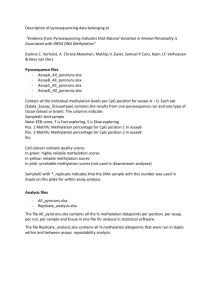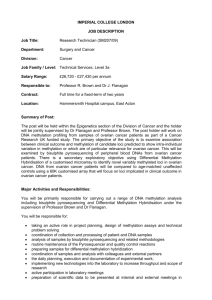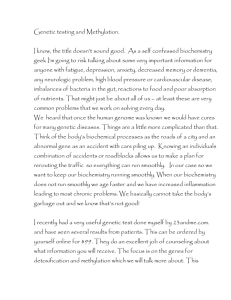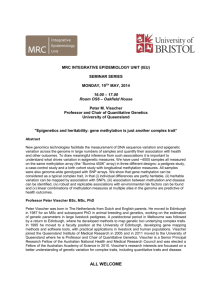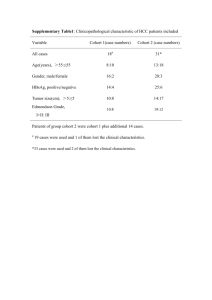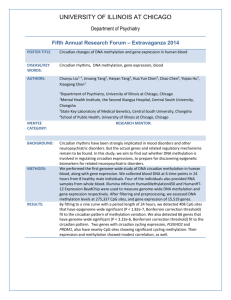Promoter methylation of P16, RARβ, E
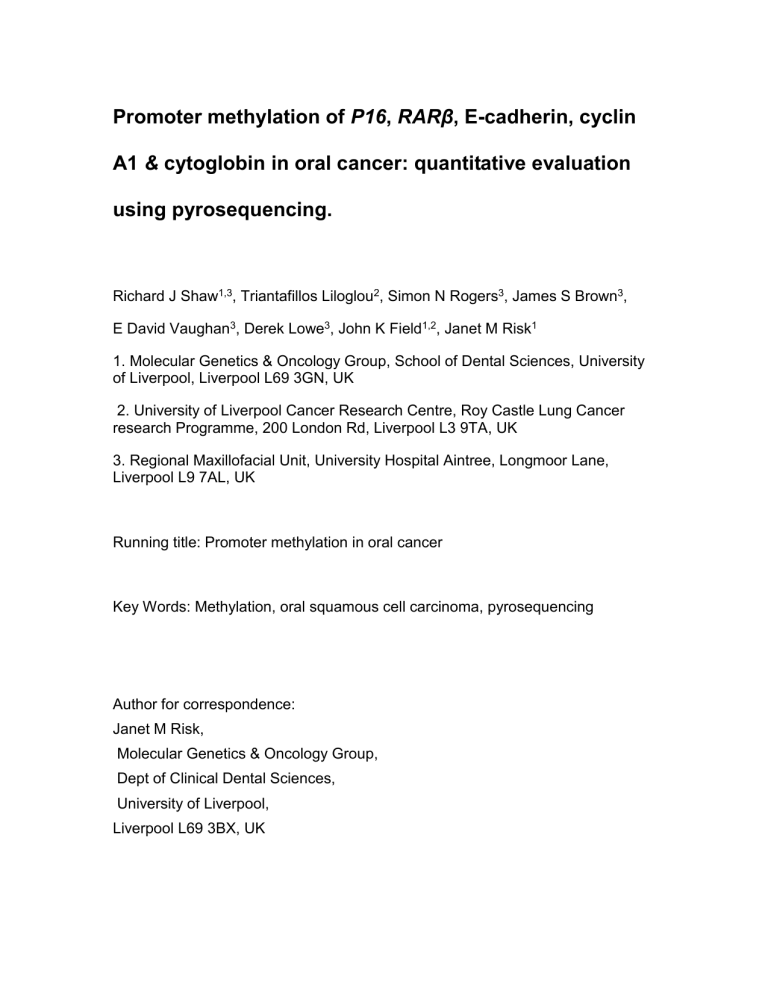
Promoter methylation of P16, RARβ, E-cadherin, cyclin
A1 & cytoglobin in oral cancer: quantitative evaluation using pyrosequencing.
Richard J Shaw 1,3 , Triantafillos Liloglou 2 , Simon N Rogers 3 , James S Brown 3 ,
E David Vaughan 3 , Derek Lowe 3 , John K Field 1,2 , Janet M Risk 1
1. Molecular Genetics & Oncology Group, School of Dental Sciences, University of Liverpool, Liverpool L69 3GN, UK
2. University of Liverpool Cancer Research Centre, Roy Castle Lung Cancer research Programme, 200 London Rd, Liverpool L3 9TA, UK
3. Regional Maxillofacial Unit, University Hospital Aintree, Longmoor Lane,
Liverpool L9 7AL, UK
Running title: Promoter methylation in oral cancer
Key Words: Methylation, oral squamous cell carcinoma, pyrosequencing
Author for correspondence:
Janet M Risk,
Molecular Genetics & Oncology Group,
Dept of Clinical Dental Sciences,
University of Liverpool,
Liverpool L69 3BX, UK
Abstract
Introduction: Methylation profiling of cancer tissues has identified this mechanism as an important component of carcinogenesis. Epigenetic silencing of tumour suppressor genes through promoter methylation has been investigated by a variety of means, the most recent of which is pyrosequencing. We have investigated quantitative methylation status in oral squamous cell carcinoma patients.
Method: Fresh tumour tissue and normal control tissue from resection margin was obtained from 79 consecutive patients undergoing resection of oral squamous cell carcinoma. DNA was extracted and bisulphite treated. PCR primers were designed to amplify 75-200bp regions of the CpG rich gene promoters of p16 , E-cadherin, cytoglobin and cyclinA1. Methylation status of 4-5
CpG sites per gene was determined by pyrosequencing.
Results: Significant CpG methylation of gene promoters within tumour specimens was found in 28% for p16 , 73% for RAR
β
, 42% for E-cadherin, 65% for cytoglobin and 53% for cyclinA1. Promoter methylation was significantly elevated in tumours compared to normal tissue for p16 (P=0.048), cytoglobin
(P=0.002) and cyclin A1 (P=0.001) but not in RAR
β
(P=0.088) or E-cadherin
(P=0.347). Concordant methylation was demonstrated in this tumour series
(P=0.03). Significant differences in degree of methylation of individual CpG sites were noted for all genes except RAR β and these differences were in a
characteristic pattern that was reproduced between tumour samples. Cyclin A1 promoter methylation showed an inverse trend with histological grade .
Conclusions: Promoter methylation analysis using pyrosequencing reveals valuable quantitative data from several CpG sites. In contrast to qualitative data generated from methylation specific PCR, our data demonstrated p16 promoter methylation in a highly tumour specific pattern. Significant tumour specific methylation of cyclin A1 promoter was also seen. Cytoglobin is a novel candidate tumour suppressor gene highly methylated in upper aero-digestive tract squamous cancer.
Introduction
The role of promoter hypermethylation has become a focus for research in many tumour sites, including head and neck cancer (HNSCC) [Fan, 2004].
Silencing of certain tumour suppressor genes, central to the development of many solid tumours, may occur in the absence of genetic change, via aberrant methylation of CpG islands [Esteller, 2003]. Several promising avenues exist in attempting to translate this research field into the clinical management of oral squamous cell cancer (OSCC). Attempts to monitor and prognosticate on the malignant transformation of oral dysplasia using methylation status have been reported [Yeh et al., 2002;McGregor et al., 2002;Lopez et al., 2003;Kresty et al.,
2002]. Early diagnosis, molecular staging and tumour surveillance of OSCC have also been explored, with particular emphasis on minimally invasive methods such as oral rinsing or blood testing [Ogi et al., 2002;Sanchez-Cespedes et al., 2000].
Furthermore, epigenetic changes, at least in principal, are reversible by pharmacological means and thus offer potential therapeutic targets [Coombes et al., 2003].
Published studies have identified a methylation profile or “methylotype” of
OSCC by the study of a limited number of genes. In particular, methylation of the promoters of P14 , P15 , P16 , RASSF1 , MGMT , DAP Kinase, and Sigma 14-3-3 have been well described [Shaw, 2005]. Some genes have been selected by their potential correlation with clinical behaviour e.g. the role of E-cadherin in cell
/ cell adhesion and metastasis [Kudo et al., 2004] and of RARβ expression in the
prediction of response to chemo-preventative agents [Wan et al., 1999]. Efforts have been made to discover genes where promoter methylation is specific to, and present in a high percentage of cases of, malignant tissue and is not found in normal oral mucosa. These requirements demand well controlled studies and, ideally, quantitative methods of methylation analysis. Microarray technology and pharmacological reversal of promoter methylation has lead to the identification of new candidate genes thought to be epigenetically silenced in HNSCC [Tokumaru et al., 2004a], but the involvement of these genes requires individual verification.
Several methods of determination of promoter methylation have been described including the use of restriction enzymes [Singer-Sam et al., 1990], genomic bisulphite sequencing [Frommer et al., 1992] and micro-array based methylation analysis [Huang et al., 1999], however the overwhelming majority of published data uses methylation specific PCR following bisulphite treatment
(MSP) [Herman et al., 1996]. MSP has been successfully performed in a large number of studies providing useful results, mainly due to its increased sensitivity.
However, it yields qualitative rather than quantitative data and usually evaluates only a few CpG sites at the 3’ end of the primers. It also lacks internal control for adequacy of bisulphite treatment (all non5 methylated cytosines should be fully converted to thymine), making identification of false positives very difficult. MSP is also potentially liable to oversensitivity following the high number of PCR cycles sometimes reported e.g. 80 cycles [An et al., 2002]. Whilst several methods have been developed to overcome these shortcomings, pyrosequencing offers a semi-quantitative, high throughput and reliable method with inbuilt
internal control for adequacy of bisulphite treatment [Dupont et al., 2004;Tost et al., 2003;Colella et al., 2003]
We have evaluated a consecutive series of previously untreated primary oral cancers using pyrosequencing to quantify promoter methylation in five genes. The commonly investigated genes, P16, RARß and E-cadherin ( ECAD ) were included in this study to allow comparison with the published MSP literature.
We also investigated the promoters of the cyclin A1 ( CYCA1 ) gene, which has recently been suggested as a promising candidate gene for epigenetic silencing in HNSCC [Tokumaru et al., 2004b], and the cytoblogin ( CYGB ) gene, which has been implicated in oesophageal and lung cancer within our own group [McRonald
FE, 2005], but not previously investigated in OSCC. Quantitative data is presented in the context of normal controls and also in the light of correlation with detailed clinical and histopathological data.
Method
Patients
79 consecutive patients presenting to the Regional Maxillofacial Unit, University
Hospital Aintree, Liverpool, UK (www.
headandneckcancer.co.uk
) with previously untreated squamous cell carcinoma of the oral cavity or oro-pharynx were consented for tissue collection following appropriate ethical committee approval.
Only those patients undergoing surgery as the primary treatment were recruited and we estimate that this includes approximately 90% of all presentations.
Demographic, clinical, pathological and outcome characteristics of each patient were recorded within the unit’s dedicated head and neck database [Rogers et al.,
1996]. Detailed histology data was recorded [Helliwell and Woolgar, 1998], providing histopathological grading and staging.
Clinical and pathological characteristics
52 of the 79 patients were male (66%) with an age range 29 to 91 years (median
60 yrs). 45 (57%) were heavy smokers (>20 pack years) and 39 (49%) admitted to alcohol use greater than 28 units/week. The commonest sites of tumours were anterior floor of mouth 20 (25%), oral tongue 18 (23%), tonsil 9 (11%) and maxilla
8 (10%). Histopathological assessment following surgical resection staged the cases as follows: pT1: 14 (18%); pT2: 30 (38%); pT3: 9 (11%); pT4: 26 (33%). 32 cases (41%) were pN positive and 21 (27%) had extra-capsular spread.
Tissue collection
Tumour samples 5mm 3 were excised from resected specimens within the tumour mass, but not involving the margin. Normal samples of similar dimension were taken from the resection margin, approx. 10mm from the macroscopic tumour edge and subsequently confirmed as benign by routine histopathology. 80 tumour and 25 normal tissue samples were collected (one patient had synchronous primary tumours), snap frozen in liquid N
2 and subsequently stored at –85 o C.
DNA extraction and bisulphite treatment
DNA was extracted from 2mm 3 tissue samples using a DNeasy
™
tissue kit
(Qiagen Ltd). DNA concentration was measured by spectrophotometry and subsequently adjusted to 40ng/µl. Bisulphite treatment of 2µg of each sample was undertaken using the EZ DNA Methylation Kit
™
(Zymo Research) and the c onverted DNA eluted in 50µl of 0.1 X TE buffer. 4µg of human genomic DNA was artificially methylated [Matsuo et al., 1994] as a positive control using Sss I
(CpG) Methylase (New England Biolabs®).
Promoter CpG island analysis and primer design
PCR assays were designed to amplify a part of the CpG islands in the examined gene promoters. Primers targeted CpG-free regions to ensure that the PCR product would proportionally represent the methylation
characteristics of the source DNA. Pyrosequencing primers were subsequently designed to focus on a series of four or five ‘target’ CpG dinucleotides and again avoided CpGs within the primer sequence (Figure
1). The targeted CpGs were chosen, where possible (P16, R ARβ, E-cad) to correlate with those specified by standard MSP primers previously described. In the case of Cyclin A1 and CYGB, target regions were selected in line with the demands of primer design as described.These target CpGs were evaluated by analysis of the resulting pyrogram.
Guanine (or cytosine if a forward sequencing primer is used) is incorporated during pyrosequencing if the template CpG was methylated, while adenine (or thymine) is incorporated if the template CpG was unmethylated. Thus the proportion of G:A (or C:T) incorporated is stoichiometrically proportional of the degree of methylation at that CpG site in the template DNA. The analysis of a non-CpG cytosine provides an internal control of the completeness of bisulphite treatment.
Pyrosequencing methylation analysis
Hotstart PCR was carried out with HotStar Taq® Master Mix Kit (Qiagen Ltd.) using 3µl bisulphite treated DNA. Confirmation of PCR product quality and freedom from contamination was established on 2% agarose gels with ethidium bromide staining. Pyrosequencing was carried out using the PSQ96MA System
(Biotage) according to manufacturer’s protocol, including single strand binding
protein (PyroGold reagents). PCR primer sequences, PCR conditions and sequencing primer sequences are given in Table 1.
Data analysis
The methylation index (MtI) at each gene promoter, and for each sample was calculated as the average value of m C/ ( m C + C) for all examined CpGs in the gene.
Statistical correlations between MtI and the clinical variables recorded were made using SPSS version 11.
Results
Methylation indices
Example bisulphite methylation profiles are shown in Figure 2. The distribution of methylation indices (MtI) for tumours and normals is presented in Table 2. There were no tumour samples that had a zero methylation index for all 5 genes, however low level methylation (0-5%) was relatively common and we consider this to represent background “noise” with questionable significance. The mean
MtIs for the positive control DNA (artificially methylated) were P16 : 0.722; RARβ :
0.165; CYGB : 0.849; CYCA1 : 0.812; ECAD : 0.702. Tumour MtI was significantly higher than that of normal tissue in the case of P16 , CYGB and CYCA1 but not
RARβ or ECAD (Kruskall-Wallis test of mean rank). This contrast is illustrated by the box and whisker plots of P16 and ECAD
MtI distribution in Figure . Seventy-
five of the tumour samples (95%) demonstrated significant methylation
(MtI>0.05) at one or more gene promoter. Pyrosequencing data was successfully generated in 100% of tested samples for P16, 95% for RARβ, 95% for CYGB,
84% for ECAD and 82% for CYCA1 . The internal controls to check for adequacy of bisulphite treatment, i.e. methylation of non CpG cytosines, suggested 100% of the DNA samples used were satisfactory in this regard.
Samples with failed results were repeated, where possible by re-preparing DNA from the original tumour specimens, however this process added little to the results suggesting that deletions may have been present in the region of the gene promoter.
Correlation between clinico-pathological and methylation data
There was little evidence of significant correlation between MtI and the clinical, demographic or pathological data studied. However, methylation at the CYCA1 gene promoter showed a trend for lower Anneroth score [Anneroth et al., 1986], a histological grading system (Spearman’s rank: rho= -0.253, P=0.05, but multiple correlations made thus NS). The significance of this is unclear as no corresponding correlations were found with tumour thickness, lymph node involvement or margin status, any or all of which might reasonably have been expected to correlate with histological grade.
Significant correlations however, were seen between methylation at RARβ and both P16 (rho= 0.29
, P=0.01 Spearman’s rank) and CYGB (rho= 0.45, P<0.001).
Weaker correlations were seen between methylation at ECAD and CYCA1
(rho=0.24, P=0.04) , ECAD and CYGB ( rho =-0.22, P=0.07
), and between P16 and CYGB (rho=0.19, P=0.10) .
This apparent interdependence of promoter methylation of genes, recently described as “concordant methylation” [An et al.,
2005], was subsequently confirmed by goodness of fit testing (chi-squared:12.8 with 5df, P=0.03 using methylation rates >5% for each gene to derive the expected number of genes with methylation if independent). The number of cases with significant methylation (MtI>0.05) at four or five of the genes studied was higher than would be expected (by a ratio of 2.1:1) if methylation was an unrelated or random event.
For each gene, the percentage of methylation at each individual CpG varied in a characteristic pattern that was reproduced between tumour samples. This is illustrated in figure 4, which shows the pattern for ECAD promoter methylation in the twenty tumours with highest MtI. Similar but less exaggerated patterns were also seen in the other genes and, in all except RARβ , the differences in methylation of different CpGs were significant (Friedman’s test: P16 , ECAD ,
CYGB , CYCA1 : P<0.001; RARβ P=0.129). These patterns of methylation were also observed in the positive control DNA prepared using DNA methylase.
Discussion
In this study we have used pyrosequencing to determine the methylation profile of oral squamous cell carcinoma in a semi-quantitative manner. Our data demonstrates tumour-specific promoter methylation is found in a significant proportion of cases at P16, CYGB and CYCA1 , whilst methylation of the promoters of ECAD and
RARβ
was also seen in surrounding normal tissues.
Patterns of concordant methylation have also been demonstrated.
p16 (INK4a) inhibits G1 to S phase passage by binding cyclin dependent kinase and preventing formation of its complex with cyclin D. Promoter methylation at
P16 has been widely investigated and reported in the literature. Rates of methylation of this promoter in OSCC vary between 31% [Maruya et al., 2004] and 67% [Kulkarni and Saranath, 2004]. Much of this MSP based literature has also found high levels in surrounding normal tissue (50%) [Kulkarni and
Saranath, 2004], dysplastic tissue (33%) [Maruya et al., 2004] and leukoplakia
44% [Lopez et al., 2003] leading to P16 methylation being previously described as an early change in oral carcinogenesis of little prognostic value. Using pyrosequencing, we found that significant methylation was found in 28% of tumours but in only 4% of the normal tissues. Our “normal” specimens were taken from the surgical resection margin and whilst frankly involved mucosal margins are uncommon in this institution [Woolgar and Triantafyllou, 2005], there would undoubtedly be a significant rate of dysplasia and molecular field change within these tissues. Drinking and smoking habits, prevalent in this population,
might also be expected to induce widespread field change in the upper aerodigestive tract [El Naggar et al., 1995;Scully et al., 2000] Our finding that P16 promoter methylation was highly tumour specific contrasts with previous published work using MSP and leads us consider the benefits of a quantitative rather than qualitative methylation assay. Pyrosequencing analysis of biopsy material from non-cancer patients and also from dysplastic keratosis would clearly be of interest.
Interest in RARß promoter methylation has developed from studies investigating the potential chemo-preventative role of retinoids in OSCC [McGregor et al.,
2002;Youssef et al., 2004a]. The effects of retinoids are though to be mediated via nuclear receptors including
RARß
[Wan et al., 1999] . MSP based studies have found 67% of tumours to show methylation of this gene promoter [Youssef et al., 2004b], and for this methylation to be significantly higher than normal surrounding tissues. Our pyrosequencing data shows significant methylation
(MtI>0.05) in 73% of tumour samples, however the trend for higher MtI in tumour than normal specimens did not reach significance (P=0.088). In our data, 62% of the normal specimens had MtI>0.05 and this appears to support existing theories that promoter methylation of RARß is widespread in apparently normal tissues as well as tumour and is, perhaps, an early event in carcinogenesis.
Epigenetic silencing of ECAD has been investigated in several studies and rates of approximately 50% in OSCC are reported [Chang et al., 2002;Hasegawa et al.,
2002;Maruya et al., 2004;Viswanathan et al., 2003;Yeh et al., 2002]. E-cadherin is a trans-membrane glycoprotein responsible for cell-cell adhesion, the reduced
expression of which has been correlated with regional metastasis in OSCC.
Whilst some studies have found a correlation with promoter methylation and propensity to metastasise [Chang et al., 2002], this finding is not undisputed [Yeh et al., 2002] and the relationship between promoter methylation and expression appears less clear than in other tumour suppressor genes. Our data suggests that ECAD promoter methylation is the least tumour specific of the five genes under investigation (P=0.347). An MtI >0.05 was present in 33% of normal tissues and indeed some of the highest MtIs for this gene were seen in normal tissues. Notably, no correlation was found between ECAD MtI and metastatic potential as determined by pN stage, number of involved nodes or extra-capsular spread. This contrasts with previous data implicating this protein in metastasis.
Cyclin A1 is a tissue-specifically expressed gene which is strongly methylated in solid tumours [Muller-Tidow et al., 2001]. A recent study using demethylation unmasking of potentially epigenetically silenced genes in HNSCC found that the
CYCA1 promoter was methylated in 45% of tumours but in none of the normal tissues [Tokumaru et al., 2004b]. Cyclin A1 is involved in apoptosis and growth arrest downstream of p53; interestingly the above study found an inverse correlation between CYCA1 promoter methylation and the presence of P53 mutations. The pyrosequencing data in our study also found methylation status to be highly tumour specific (P=0.001) with 53% of tumours having an MtI>0.05.
Interestingly our data showed a significant inverse trend between CYCA1 MtI and
Anneroth score, however this was in the absence of significant correlations with individual measures of histological grade and the statistical significance was
borderline. P53 mutations are present in around 50% of OSCC tumours and have been shown in some studies to correlate with poor prognosis and radioresistance [Schliephake, 2003;Yamazaki et al., 2003]. It will be interesting to obtain outcome data for our cohort and determine whether those with CYCA1
Promoter methylation have better prognosis.
CYGB is a candidate tumour-suppressor gene on chromosome 17q and is the only gene completely contained within the 42.5kb Tylosis with Oesophageal
Cancer minimal region [Risk et al., 2002]. This region is subject to frequent deletions in sporadic oesophageal cancer, however no coding mutations have been demonstrated in affected tylosis patients [Langan et al., 2004;Shahabi et al., 2004]. Cytoglobin is a recently described, intracellular globin [Burmester et al., 2002;Burmester et al., 2004] whose role in cancer is as yet unclear but may be related to detoxification of oxygen free radicals [Trent, III and Hargrove, 2002].
Promoter methylation of CYGB in lung cancer has recently become the focus of investigation within our research group and may be implicated in ovarian cancer
[Presneau et al., 2005]. The CYGB promoter was found to be significantly methylated in 46% of lung tumour specimens and significantly fewer normal controls. Further the MtI of CYGB in lung tumours correlated with RNA expression (P=0.001). In OSCC, we now find that the CYGB promoter is significantly methylated in 65% of tumours and, further, that methylation is highly tumour specific (P=0.002). Recently presented pilot micro-array data also reveals that CYGB is consistently downregulated in head and neck cancer [Thurlow JK,
2005]. The epigenetic data presented in this study adds weight to the hypothesis
that CYGB is a tumour suppressor gene highly methylated in upper aerodigestive tract squamous cancer.
The pattern of variable CpG methylation seen within gene promoters is a new finding made possible by the highly detailed data generated from pyrosequencing. Explanations underlying these methylation patterns, as seen in
Figure 4, are currently a matter for speculation. It is possible that these changes result from experimental artefact, but there is an observable trend towards lower methylation at any CpG located only a few nucleotides away from a CpG with high methylation. It may be that steric hindrance of DNA methylase does not allow equally high methylation of two closely adjacent CpGs (personal communication: Dr Jorg Tost, Centre National de Genotypage, Evry, France &
Prof Ralph Krahe, MD Anderson Cancer Centre, Texas, USA). Full explanation of these apparent subtleties however, awaits further investigation. Our finding is that these patterns of CpG methylation are characteristic in any one gene promoter and highly reproducible between samples. We believe this adds weight to our use of methylation index in analysis, rather than concentrating on an individual single CpG site.
The inter-relationship between promoter methylation at several genes (or
“concordant methylation”) is worthy of further discussion. The number of cases with significant methylation (MtI>0.05) at four or five of the genes studied was higher than would be expected (21 vs 10) if methylation was a random event.
This finding suggests the possibility that there is a sub-group of tumours that may have a predominant epigenetic pathogenesis. Other sub-groups may have
principally genetic pathogenesis with deletions and mutations being more prevalent than promoter methylation. This hypothesis would need to be tested by examining a wide range of both genetic and epigenetic aberrations within the same cohort. The pathological significance of this CpG island methylation phenotype (CIMP) [Issa, 2004] recently described in other tumour sites was not seen in this series. This aspect, however, may be worthy of further investigation when clinical outcome data from our series become available and as further genes are studied. We feel that the quantitative data generated as we describe will add valuable insight to explore this concept.
In conclusion, we have used pyrosequencing technology to uncover further details of the epigenetic profile of oral squamous cell cancer. Our data indicate that P16 promoter methylation is highly tumour specific, in contrast to some previously published MSP data, whilst CYCA1 promoter methylation has not previously been investigated in an oral cancer series and also appears to be tumour specific. The role of CYGB as a tumour suppressor gene in oral cancer is also novel and awaits further investigation.
Acknowledgements
RJS is in receipt of a Royal College of Surgeons of England Research
Fellowship; research was funded by the British Association of Oral and
Maxillofacial Surgeons; TL is funded by the Roy Castle Foundation.
Table 1 PCR Primers and conditions p16
Gene
E-Cadherin
(CDH1)
RARβ 3
CyclinA1
Cytoglobin
(CYGB)
33
35
39
44
-589
-598
-600
-604
-504
-507
-510
-514
Assay
CpG 1
-53
-57
-59
-64
-144
-150
-158
-160 control
C
-51
-163
48
-596
-492
Primers 2
Forward PCR AGGGGTTGGTTGGTTATTAG
Reverse PCR Biotin-CTACCTACTCTCCCCCTCTC
Sequencing (F) GGTTGGTTATTAGAGGGT
Forward PCR TTTGATTTTAGGTTTTAGTGAGT
Reverse PCR Biotin-ACCACAACCAATCAACAA
Sequencing (F) TAGTAATTTTAGGTTAGAGG
Forward PCR Biotin-GTTAAAGGGGGGATTAGAAT
Reverse PCR CTCCTTCCAAATAAATACTTACAA
Sequencing (R) ACCCAAACAAACCCT
Forward PCR Biotin-GAGTTAGGGTTTTTAGGA
Reverse PCR CCTCCAACTCCAACTATAC
Sequencing (R) CTAACAACCCCCTCTA
Forward PCR Biotin-GGGAATTGATTTAAAGTTTA
Reverse PCR AAAAAACCCAACTAAATCCAC
Sequencing (R) ACCCAACTAAATCCAC
94 C
(14:30m)
95 C
(14:30m)
94 C
(14:30m)
95 C
(14:30m)
95 C
(14:30m)
1. Relative to transcription start of gene studied
2. (F): sequencing primer extends in the F direction; (R): sequencing primer extends in the R direction
3. Examined CpGs in 5’UTR
PCR Conditions
94 O C 30s
58 O C 40s
72 O C 30s
94 O C 30s
55 O C 30s
40 cycles
72 C
(10:00m)
72 O C 30s
40 cycles
72 C
(10:00m)
94 O C 30s
58 O C 40s
72 O C 30s
94 O C 30s
55 O C 30s
72 O C 30s
94 O C 30s
52 O C 45s
72 O C 30s
40 cycles
40 cycles
40 cycles
72 C
(10:00m)
72 C
(10:00m)
72 C
(10:00m)
Figure 1: PCR and sequencing primers for the cytoglobin gene promoter
MtI=0.000
MtI=0.369
Figure 2. Representative pyrograms for RARβ.
The four targeted cytosines are enclosed in unshaded squares (as reverse strand was read, G peaks [arrowed] indicate methylated cytosine while A indicates unmethylated cytosine). The control, non-CpG cytosine residue showing complete conversion of cytosine to uracil by bisulphite treatment is shown in the left-hand shaded box. Normal tissue (top panel) demonstrates no methylation while tumour tissue (bottom panel) demonstrates a significant level of methylation at all four target bases. The Methylation Index (MtI) is calculated as the average rate of G incorporation at each CpG.
Gene
% samples
MtI 1 >0
% samples
MtI >5% 3
Kruskall-Wallis test of mean rank (diff. T/N)
Reference
MtI 2
% tumours
≥Reference MtI
P16
RAR β
CYGB
CYCA1
ECAD
T
N
T
N
T
N
T
N
T
N
45% (36/80)
27% (7/26)
28% (22/80)
4% (1/26)
85% (68/80) 73% (58/80)
71% (15/21) 62% (13/21)
74% (59/80) 65% (52/80)
57% (12/21) 52% (11/21)
72% (56/78) 53% (42/78)
11% (1/ 9)
83% (59/71)
56% (10/18)
0% (0/9)
42% (30/71)
33% (6/18)
Table 2 : Methylation data and analysis
P=0.048
P=0.088 (NS)
P=0.002
P=0.001
P=0.347 (NS)
1. MtI = Methylation Index (mean of % methylation at all CpGs / 100)
2. MtI below which 95% of normal sample data fall
3 0-5% methylation is considered to be due to experimental background
0.046
0.215
0.149
0.002
0.218
22/ 80 28%
15/ 80 19%
35/ 80 44%
38/ 78 49%
1/ 71 1%
40
30
60
50
20
10
0
N =
60
30
20
50
40
10
0
N =
80 tumours
80 tumours
26 normals
21 normals
20
10
0
N =
40
30
60
50
20
10
0
N =
40
30
80 tumours
71 tumours
21 normals
18 normals
40
30
60
50
20
10
0
N = 78 tumours
9 normals
Figure 3: Box and whisker plots of Methylation Indices for 5 genes studied
Boxes include 50% data, O = Outlier ‘cases with values between 1.5 and 3 box lengths from the upper or lower edge of the box. The box length is the interquartile range.
’ *=
Extreme ‘cases with values more than 3 box lengths from the upper or lower edge of the box ’
Figure 4: CpG methylation patterns within promoter regions of 5 genes studied.
Reference List
An C, Choi IS, Yao JC, Worah S, Xie K, Mansfield PF, Ajani JA, Rashid A,
Hamilton SR, Wu TT (2005) Prognostic significance of CpG island methylator phenotype and microsatellite instability in gastric carcinoma. Clin Cancer Res 11:
656-663
An Q, Liu Y, Gao Y, Huang J, Fong X, Li L, Zhang D, Cheng S (2002) Detection of p16 hypermethylation in circulating plasma DNA of non-small cell lung cancer patients. Cancer Lett 188: 109-114
Anneroth G, Batsakis JG, Luna M (1986) Malignancy grading of squamous cell carcinoma in the floor of the mouth related to clinical evaluation. Scand J Dent
Res 94: 347-356
Burmester T, Ebner B, Weich B, Hankeln T (2002) Cytoglobin: a novel globin type ubiquitously expressed in vertebrate tissues. Mol Biol Evol 19: 416-421
Burmester T, Haberkamp M, Mitz S, Roesner A, Schmidt M, Ebner B, Gerlach F,
Fuchs C, Hankeln T (2004) Neuroglobin and cytoglobin: genes, proteins and evolution. IUBMB Life 56: 703-707
Chang HW, Chow V, Lam KY, Wei WI, Yuen A (2002) Loss of E-cadherin expression resulting from promoter hypermethylation in oral tongue carcinoma and its prognostic significance. Cancer 94: 386-392
Colella S, Shen L, Baggerly KA, Issa JP, Krahe R (2003) Sensitive and quantitative universal Pyrosequencing methylation analysis of CpG sites.
Biotechniques 35: 146-150
Coombes MM, Briggs KL, Bone JR, Clayman GL, El Naggar AK, Dent SY (2003)
Resetting the histone code at CDKN2A in HNSCC by inhibition of DNA methylation. Oncogene 22: 8902-8911
Dupont JM, Tost J, Jammes H, Gut IG (2004) De novo quantitative bisulfite sequencing using the pyrosequencing technology. Anal Biochem 333: 119-127
El Naggar AK, Hurr K, Batsakis JG, Luna MA, Goepfert H, Huff V (1995)
Sequential loss of heterozygosity at microsatellite motifs in preinvasive and invasive head and neck squamous carcinoma. Cancer Res 55: 2656-2659
Esteller M (2003) Cancer epigenetics: DNA methylation and chromatin alterations in human cancer. Adv Exp Med Biol 532: 39-49
Fan CY (2004) Epigenetic alterations in head and neck cancer: prevalence, clinical significance, and implications. Curr Oncol Rep 6: 152-161
Frommer M, McDonald LE, Millar DS, Collis CM, Watt F, Grigg GW, Molloy PL,
Paul CL (1992) A genomic sequencing protocol that yields a positive display of 5methylcytosine residues in individual DNA strands. Proc Natl Acad Sci U S A 89:
1827-1831
Hasegawa M, Nelson HH, Peters E, Ringstrom E, Posner M, Kelsey KT (2002)
Patterns of gene promoter methylation in squamous cell cancer of the head and neck. Oncogene 21: 4231-4236
Helliwell TR, Woolgar JA (1998) Standards and minimum datasets for reporting common cancers. Minimum dataset for head and neck carcinoma reports. The
Royal College of Pathologists.
Herman JG, Graff JR, Myohanen S, Nelkin BD, Baylin SB (1996) Methylationspecific PCR: a novel PCR assay for methylation status of CpG islands. Proc
Natl Acad Sci U S A 93: 9821-9826
Huang TH, Perry MR, Laux DE (1999) Methylation profiling of CpG islands in human breast cancer cells. Hum Mol Genet 8: 459-470
Issa JP (2004) CpG island methylator phenotype in cancer. Nat Rev Cancer 4:
988-993
Kresty LA, Mallery SR, Knobloch TJ, Song H, Lloyd M, Casto BC, Weghorst CM
(2002) Alterations of p16(INK4a) and p14(ARF) in patients with severe oral epithelial dysplasia. Cancer Res 62: 5295-5300
Kudo Y, Kitajima S, Ogawa I, Hiraoka M, Sargolzaei S, Keikhaee MR, Sato S,
Miyauchi M, Takata T (2004) Invasion and metastasis of oral cancer cells require methylation of E-cadherin and/or degradation of membranous beta-catenin. Clin
Cancer Res 10: 5455-5463
Kulkarni V, Saranath D (2004) Concurrent hypermethylation of multiple regulatory genes in chewing tobacco associated oral squamous cell carcinomas and adjacent normal tissues. Oral Oncol 40: 145-153
Langan JE, Cole CG, Huckle EJ, Byrne S, McRonald FE, Rowbottom L, Ellis A,
Shaw JM, Leigh IM, Kelsell DP, Dunham I, Field JK, Risk JM (2004) Novel microsatellite markers and single nucleotide polymorphisms refine the tylosis with oesophageal cancer (TOC) minimal region on 17q25 to 42.5 kb: sequencing does not identify the causative gene. Hum Genet 114: 534-540
Lopez M, Aguirre JM, Cuevas N, Anzola M, Videgain J, Aguirregaviria J, Martinez dP (2003) Gene promoter hypermethylation in oral rinses of leukoplakia patients-
-a diagnostic and/or prognostic tool? Eur J Cancer 39: 2306-2309
Maruya S, Issa JP, Weber RS, Rosenthal DI, Haviland JC, Lotan R, El Naggar
AK (2004) Differential methylation status of tumor-associated genes in head and neck squamous carcinoma: incidence and potential implications. Clin Cancer Res
10: 3825-3830
Matsuo K, Silke J, Gramatikoff K, Schaffner W (1994) The CpG-specific methylase SssI has topoisomerase activity in the presence of Mg2+. Nucleic
Acids Res 22: 5354-5359
McGregor F, Muntoni A, Fleming J, Brown J, Felix DH, MacDonald DG,
Parkinson EK, Harrison PR (2002) Molecular changes associated with oral dysplasia progression and acquisition of immortality: potential for its reversal by
5-azacytidine. Cancer Res 62: 4757-4766
McRonald FE, Xinarianos G Bowers NA Risk JM Field JK Liloglou T. Expression downregulation and promoter methylation of Cytoglobin in non-small cell lung cancer. 2005.
Ref Type: Unpublished Work
Muller-Tidow C, Bornemann C, Diederichs S, Westermann A, Klumpen S, Zuo P,
Wang W, Berdel WE, Serve H (2001) Analyses of the genomic methylation status of the human cyclin A1 promoter by a novel real-time PCR-based methodology.
FEBS Lett 490: 75-78
Ogi K, Toyota M, Ohe-Toyota M, Tanaka N, Noguchi M, Sonoda T, Kohama G,
Tokino T (2002) Aberrant methylation of multiple genes and clinicopathological features in oral squamous cell carcinoma. Clin Cancer Res 8: 3164-3171
Presneau N, Dewar K, Forgetta V, Provencher D, Mes-Masson AM, Tonin PN
(2005) Loss of heterozygosity and transcriptome analyses of a 1.2 Mb candidate ovarian cancer tumor suppressor locus region at 17q25.1-q25.2. Mol Carcinog
43: 141-154
Risk JM, Evans KE, Jones J, Langan JE, Rowbottom L, McRonald FE, Mills HS,
Ellis A, Shaw JM, Leigh IM, Kelsell DP, Field JK (2002) Characterization of a 500 kb region on 17q25 and the exclusion of candidate genes as the familial Tylosis
Oesophageal Cancer (TOC) locus. Oncogene 21: 6395-6402
Rogers SN, Beirne JC, Patel M, Vaughan ED, Brown JS (1996) A clinician friendly computerised head and neck oncology audit: the first year results. Ann R
Coll Surg Engl 78: 14-18
Sanchez-Cespedes M, Esteller M, Wu L, Nawroz-Danish H, Yoo GH, Koch WM,
Jen J, Herman JG, Sidransky D (2000) Gene promoter hypermethylation in tumors and serum of head and neck cancer patients. Cancer Res 60: 892-895
Schliephake H (2003) Prognostic relevance of molecular markers of oral cancer-a review. Int J Oral Maxillofac Surg 32: 233-245
Scully C, Field JK, Tanzawa H (2000) Genetic aberrations in oral or head and neck squamous cell carcinoma 3: clinico-pathological applications. Oral Oncol
36: 404-413
Shahabi M, Noori Daloii MR, Langan JE, Rowbottom L, Jahanzad E, Khoshbin E,
Taghikhani M, Field JK, Risk JM (2004) An investigation of the tylosis with oesophageal cancer (TOC) locus in Iranian patients with oesophageal squamous cell carcinoma. Int J Oncol 25: 389-395
Shaw RJ (2005) The epigenetics of oral cancer (in press). Int J Oral Maxillofac
Sug doi: 10.1016/j.ijom.2005.06.014:
Singer-Sam J, LeBon JM, Tanguay RL, Riggs AD (1990) A quantitative HpaII-
PCR assay to measure methylation of DNA from a small number of cells. Nucleic
Acids Res 18: 687
Thurlow JK, Hunter KD Flemming J Drake PJH Vass JK Kalna G Higham D
Herzyk P MacDonald DG Parkinson EK Harrison PR. Expression Profile of
HNSCC in Relation to Immortality and Invasion Patterns, NCRI Conference,
Birmingham 2005. 2-10-2005.
Ref Type: Conference Proceeding
Tokumaru Y, Yamashita K, Osada M, Nomoto S, Sun DI, Xiao Y, Hoque MO,
Westra WH, Califano JA, Sidransky D (2004b) Inverse correlation between cyclin
A1 hypermethylation and p53 mutation in head and neck cancer identified by reversal of epigenetic silencing. Cancer Res 64: 5982-5987
Tokumaru Y, Yamashita K, Osada M, Nomoto S, Sun DI, Xiao Y, Hoque MO,
Westra WH, Califano JA, Sidransky D (2004a) Inverse correlation between cyclin
A1 hypermethylation and p53 mutation in head and neck cancer identified by reversal of epigenetic silencing. Cancer Res 64: 5982-5987
Tost J, Dunker J, Gut IG (2003) Analysis and quantification of multiple methylation variable positions in CpG islands by Pyrosequencing. Biotechniques
35: 152-156
Trent JT, III, Hargrove MS (2002) A ubiquitously expressed human hexacoordinate hemoglobin. J Biol Chem 277: 19538-19545
Viswanathan M, Tsuchida N, Shanmugam G (2003) Promoter hypermethylation profile of tumor-associated genes p16, p15, hMLH1, MGMT and E-cadherin in oral squamous cell carcinoma. Int J Cancer 105: 41-46
Wan H, Oridate N, Lotan D, Hong WK, Lotan R (1999) Overexpression of retinoic acid receptor beta in head and neck squamous cell carcinoma cells increases their sensitivity to retinoid-induced suppression of squamous differentiation by retinoids. Cancer Res 59: 3518-3526
Woolgar JA, Triantafyllou A (2005) A histopathological appraisal of surgical margins in oral and oropharyngeal cancer resection specimens. Oral Oncol
Yamazaki Y, Chiba I, Hirai A, Sugiura C, Notani K, Kashiwazaki H, Tei K,
Totsuka Y, Fukuda H (2003) Specific p53 mutations predict poor prognosis in oral squamous cell carcinoma. Oral Oncol 39: 163-169
Yeh KT, Shih MC, Lin TH, Chen JC, Chang JY, Kao CF, Lin KL, Chang JG
(2002) The correlation between CpG methylation on promoter and protein expression of E-cadherin in oral squamous cell carcinoma. Anticancer Res 22:
3971-3975
Youssef EM, Issa JP, Lotan R (2004a) Regulation of RARbeta1 expression in head and neck cancer cells by cell density-dependent chromatin remodeling.
Cancer Biol Ther 3: 1002-1006
Youssef EM, Lotan D, Issa JP, Wakasa K, Fan YH, Mao L, Hassan K, Feng L,
Lee JJ, Lippman SM, Hong WK, Lotan R (2004b) Hypermethylation of the retinoic acid receptor-beta(2) gene in head and neck carcinogenesis. Clin Cancer
Res 10: 1733-1742

